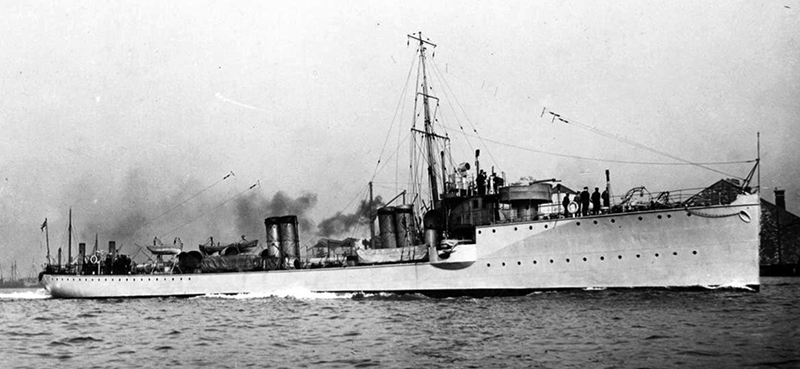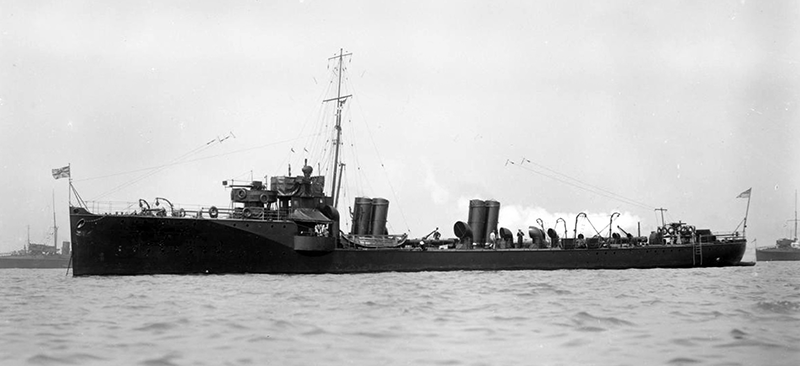

Erne 1905
|
Name |
No |
Yard No |
Builder |
Laid down |
Launched |
Comp |
Fate |
|
Erne |
N58 |
Palmer, Jarrow |
3.7.1902 |
14.1.1903 |
2/1904 |
wrecked 6.2.1915 |
|
| Ettrick | N01, D18, D32 | Palmer, Jarrow | 9.7.1902 | 28.3.1903 | 2.1904 | sold 5.1919 | |
| Exe | N05, D19, D33, H70 | Palmer, Jarrow | 14.7.1902 | 27.4.1903 | 3.1904 | sold 2.1920 |
|
Displacement normal, t |
550 |
|
Displacement full, t |
620 |
|
Length, m |
71.2 oa 68.6 pp |
|
Breadth, m |
7.16 |
|
Draught, m |
2.97 |
|
No of shafts |
2 |
|
Machinery |
2 VTE, 4 Reed boilers |
|
Power, h. p. |
7000 |
|
Max speed, kts |
25.5 |
|
Fuel, t |
coal 127 |
|
Endurance, nm(kts) |
420(25) |
|
Armament |
1 x 1 - 76/40 12pdr 12cwt QF Mk I, 5 x 1 - 57/40 6pdr Hotchkiss Mk I, 2 x 1 - 450 TT (4) |
|
Complement |
70 |
Project history:
Experience with earlier types of destroyer had shown quite clearly that
concentrating on high trial (= smooth water) speed was a snare and delusion. The
combination of seaworthiness with the ability to maintain a less spectacular
speed when it became rough was of far more real value. The early destroyers were
too lightly built, too small and too delicate to be fully effective in all
conditions as fighting ships. The lesson was underlined by the success of the
German S90 class which had a raised forecastle and proved very seaworthy.
The Admiralty decided therefore to ask for more heavily built destroyers with
raised forecastles and a contract speed of only 25.5kts, The larger size and
sturdiness of the new design was correctly held to allow the new destroyers to
maintain this speed in most conditions when the earlier destroyers dropped well
below it.
The raised forecastle proved a particularly desirable feature
as it enabled speed to be kept up when steaming into waves and also allowed the
forward guns to be fought in comparatively bad conditions, besides keeping the
watchkeepers much drier. The latters' condition was much improved anyway by
being given a bridge. The armament of this class was identical to the
30-knotters, the forward 57mm guns being sponsoned out on either side of the
forefunnel in the first group. However this made their positions somewhat wet in
a head sea, so in the 1902/3 group and subsequent ships they were moved up
to either side of the 76mm on the forecastle. Experience in the Russo-Japanese
war showed that the 57mm was too light for real effect, and so in 1906 it was
decided to replace the 5 57mm with 3 76mm, thereby giving a total of 4 12pdr as
well as the 2 450mm TT.
These vessels marked the real break between the torpedo boat
and the true destroyer, and set the pattern for destroyer development both in
Britain and in most foreign countries until the 'V & W' class of the latter part
of the 1914-18 war. One, the Eden, was given turbine propulsion. The
class gave good service, being used in the First World War on patrol and escort
duties. They had been designated the 'E' class in 1912. They were generally
considered less easy to manoeuvre than earlier destroyers, and much more visible
thanks to their higher silhouette and therefore less suited to surprise torpedo
attacks. Their lower smooth water speed caused them to be the target of much
ill-informed public criticism, but experience showed just how ignorant this
criticism was, as effective speed was so much better. All had a speed of 25.5kts
(the fastest on trials being Eden and Gala with 26.2kts).
The Palmer boats had four funnels in two close groups. 1901/2
Programme.
Modernizations: 1907-1908, all: - 5 x 1 - 57/40; + 3 x 1 - 76/28 12pdr 8cwt QF Mk I
Naval service: Erne was wrecked on Rattray Head 6.2.1915.

Exe

Erne
© Navypedia, 2020